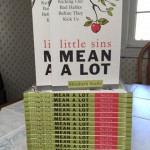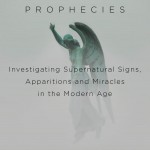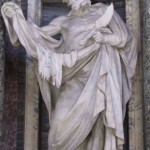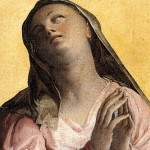Last year, I gave an 8 minute podcast talking about this solemnity. It’s one of the biggies in the church, and for a good reason. As St. Anselm teaches us from across the centuries in today’s Office of Readings:
God begot the Son, through whom all things were made, and Mary gave birth to him as the Savior of the world. WIthout God’s Son, nothing could exist; without Mary’s Son, nothing could be redeemed.
Or, as St. John Vianney taught:
“The Father takes pleasure in looking upon the heart of the most holy Virgin Mary, as the masterpiece of his hands…The Son takes pleasure in it as the heart of his Mother, the source from which he drew the blood that has ransomed us.”
Salvation and Incarnation are mysteries that cannot be pondered too often, and the greatest of mysteries involve Mary. Sin entered the world through a woman’s assistance to the Destructor; Redemption and Salvation enter the world through a woman’s assistance to the Creator. Woman was created out of Adam; Christ entered out of Mary, the New Eve. All humanity is raised to wholeness by the God who promised in the very first book of scripture, that the end was pre-ordained.
God chose us in him
before the world began,
to be holy
and blameless in his sight.
– Ephesians
Thinking along these lines, I have just read a very interesting book that has nothing at all to do with Mary, except, really, it does. The author simply does not realize it because -like many Protestants- he hasn’t given much thought to Mary. At one point in fact, he works rather hard at not thinking about Mary, when she is literally right before his eyes, making his case of beginnings and endings for him.
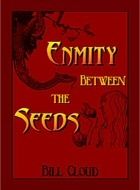
The book is Bill Cloud’s Enmity Between the Seeds, and it is a provocative read; Cloud maintains that the “end times” were fully revealed to us in the Beginning. Having studied with prominent rabbinical scholars, Cloud uses the Torah to connect the New Testament to the promises of the old, most specifically to discuss the paradox of the seeds which bear the fruit which produce the seeds -just like the God who creates, who is created within his creation- and the notion that a seed is what a thing is, and it cannot be anything else; the genuineness and authenticity of wheat seeds and weeds are what they are. While they may grow together, neither are changed in essentials. What is righteous is righteous; what is corrupt is corrupt.
I liked parts of the book very much, other parts rather less so; nor did I agree with all of it, but I still found much to ponder. There were times I wished he’d had an editor to tell him, “stop repeating, you’ve made your point,” but I can be verbose, sometimes, so I did sympathize.
I’ll talk more about Enmity Between the Seeds another time; we’ll explore -among other things- some of the Marian themes that Cloud seemed to work very hard at missing. For now, though, since we are talking about the Immaculate Conception of Mary, let’s examine one of Cloud’s musings that -for me- makes the case for the Catholic dogma that Mary -the Ark of the New Covenant- was born free of stain of sin wrought by Adam and Eve.
Cloud writes:
Where did [Righteous] Abel [who sacrificed not just meal but flesh, as well] learn of this need for redemption, considering there was no written Torah to read? I believe the Bible, in veiled fashion, points to his father Adam who learned it directly from the Heavenly Father. In order to comprehend the basis for this hypothesis, we must once again call upon the methods of study addressed earlier.
When Adam and Eve hid from the presence of the Lord, they attempted to conceal their newly discovered nakedness with fig leaves. Adam knew that their indiscretion would result in severe consequences, so he and the woman hid among the trees of the garden. Perhaps by hiding he was trying to delay the inevitable death sure to come. Had not the Lord said, “For in the day that you eat of it, you shall surely die.” (Gen. 2:17?)
When God found them, He judged them for their actions. He expelled them and separated them from His presence as a consequence, and he cursed the ground so Adam would remember on a daily basis what his disobedience had cost him . . .yet on that day, God did not destroy him and the woman. To the contrary, He displayed true justice -stern judgment tempered with unmerited mercy. Where is the evidence of his mercy? It is found in the promise of a Redeemer (Gen. 3:15)
I was struck that God “separated them from his presence,” and why? Because as Cloud says elsewhere, Adam and Eve were now stained with their sin, and unable to remain in the presence of the One who is all Good, all Holiness. Their corruption makes them unfit to reside with the absolute purity of his Being; like wheat and chaff, they must be differentiated. In a manner of speaking, “like with like; kind with kind.”
This reinforced for me, the notion that Mary -as the singular vessel, full of grace, by which God would Incarnate- could only have been without stain of sin, from the very moment of her conception; otherwise the All-Good, All-Holy could not have resided and grown within her. If what was stained with sin could not reside in Eden with God, that God could not reside in Mary, were she similarly stained. In “veiled fashion” we see the theme Cloud returns to repeatedly: “Like with like, kind with kind;” the purity of the Christ could not have enfleshed within what was corrupt, or less than pure.
Cloud’s thesis spoke to me because I’d come to a similar recognition of Genesis’ New Testament mirrors a few years ago:
If we think back to those lines from Genesis, and John, we can almost consider Mary-in-utero to be a sort of mirror of the quiescent “nothing” that existed before Creation. A created creature, loved into being and marked by grace, lies waiting to be born. She lives and grows obscurely, still this model of quiescence.
Then there is movement. God stirs, but this time, instead of saying, “Let there be…(light, etc)” it is the created creature who says the Word as she utters her Fiat. “Yes,” she says, “let it be…”
The words of Creation, of positive assent, affirmation, words that permit life rather than refuse. Thus creature co-operates with creator and there comes a second, more muted, but not discreet “big bang” (what’s discreet about angels, shepherds and kings?) and the world is made anew. New Creation. New Creatures.
From the stillpoint “nothing” of Mary’s physical and spiritual blank sheet, comes the rest of the story. Salvation. Return. The Way back to where we started.
This has relevance with regards to the Assumption of Mary, another Dogma which causes difficulty for many Protestants (and I’m sure, some Catholics). But it makes sense that -rather like Elijah- Mary would be assumed into heaven when her dormition came. (“For you will not leave my soul among the dead/nor let your beloved know decay.” -Psalm 16:10) Would the Ark of the Covenant have been left to corruption, or would it be taken to a worthy place?
Mary was only human, and her son was also her savior. But being outside of time, Christ saved her first. The firstborn of all creation, he preceded Mary, and she -the greatest of his human creation- delivered him unto us. Christ needed his vessel pristine, and grace-filled. The seed can only enflesh to what it is -an apple cannot grow within the rind of an orange- and within its flesh, lies the seed of creation.
St. Anselm, again:
Through Mary God made himself a Son, not different but the same, by nature Son of God, and Son of Mary. The whole universe was created by God, and God was born of Mary. God created all things, and Mary gave birth to God.
This God of paradoxes and mirrors – He is a most intriguing God, at once intimate and unknowable.
Delicious mystery of faith.
Related:
Advent Pictures of Christ
O Eve; Reconciled!
Lent: Who Told You that You Were Naked?
Also writing:
Was Christ her Savior?
Danielle Bean
Mary’s Immaculate Conception Points the Way
Deacon Greg
Passionists: A nice Advent idea


